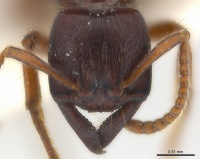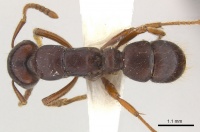Gnamptogenys haenschi
| Gnamptogenys haenschi | |
|---|---|

| |
| Scientific classification | |
| Kingdom: | Animalia |
| Phylum: | Arthropoda |
| Class: | Insecta |
| Order: | Hymenoptera |
| Family: | Formicidae |
| Subfamily: | Ectatomminae |
| Tribe: | Ectatommini |
| Genus: | Gnamptogenys |
| Species: | G. haenschi |
| Binomial name | |
| Gnamptogenys haenschi (Emery, 1902) | |
This species inhabitats forest and apparently nests in rotten wood as well as in soil. It has also been taken in oil palm plantations. Some specimens were collected from carrion traps baited with iguana meat. Longino (pers. comm.) reports finding a nest beneath a rotten log; the ants burrowed into the soil on exposure. (Lattke 1995)
Identification
A member of the concinna species group. Vertexal margin concave in frontal view; mandibles with longitudinal costulae; declivitous propodeal face with longitudinal striae superiorly and basally transverse rugae; petiolar node transverse; postpetiolar sternum mostly transversely strigulate; no metacoxal tooth. (Lattke 1995)
Keys including this Species
Distribution
Latitudinal Distribution Pattern
Latitudinal Range: 25.68015° to -64.36°.
| North Temperate |
North Subtropical |
Tropical | South Subtropical |
South Temperate |
- Source: AntMaps
Distribution based on Regional Taxon Lists
Neotropical Region: Argentina, Bolivia, Brazil, Colombia, Costa Rica, Ecuador (type locality), Peru.
Distribution based on AntMaps
Distribution based on AntWeb specimens
Check data from AntWeb
Countries Occupied
| Number of countries occupied by this species based on AntWiki Regional Taxon Lists. In general, fewer countries occupied indicates a narrower range, while more countries indicates a more widespread species. |

|
Estimated Abundance
| Relative abundance based on number of AntMaps records per species (this species within the purple bar). Fewer records (to the left) indicates a less abundant/encountered species while more records (to the right) indicates more abundant/encountered species. |

|
Biology
Castes
Nomenclature
The following information is derived from Barry Bolton's Online Catalogue of the Ants of the World.
- haenschi. Ectatomma (Gnamptogenys) haenschi Emery, 1902c: 27 (q.) ECUADOR.
- Type-material: holotype queen.
- Type-locality: Ecuador: Coca (R. Haensch).
- Type-depository: MSNG.
- [Misspelled as haenschei by Bezděčková, et al. 2015: 111.]
- Brown, 1958g: 302 (w.).
- Combination in Gnamptogenys: Brown, 1958g: 302; Camacho, Franco, Branstetter, et al. 2022: 11.
- Status as species: Emery, 1911d: 45; Brown, 1958g: 228, 302; Kempf, 1972a: 112; Bolton, 1995b: 209; Lattke, 1995: 169; Lattke, et al. 2004: 345; Lattke, et al. 2007: 259, 263 (in key); Lattke, et al. 2008: 89; Bezděčková, et al. 2015: 111; Feitosa, 2015c: 98; Feitosa & Prada-Achiardi, 2019: 672; Camacho, et al. 2020: 457, 461 (in key); Camacho, Franco, Branstetter, et al. 2022: 11.
- Distribution: Argentina, Bolivia, Brazil, Colombia, Costa Rica, Ecuador, French Guiana, Nicaragua, Panama, Peru, Venezuela.
Description
References
- Albuquerque, E., Prado, L., Andrade-Silva, J., Siqueira, E., Sampaio, K., Alves, D., Brandão, C., Andrade, P., Feitosa, R., Koch, E., Delabie, J., Fernandes, I., Baccaro, F., Souza, J., Almeida, R., Silva, R. 2021. Ants of the State of Pará, Brazil: a historical and comprehensive dataset of a key biodiversity hotspot in the Amazon Basin. Zootaxa 5001, 1–83 (doi:10.11646/zootaxa.5001.1.1).
- Brown, W. L., Jr. 1958g. Contributions toward a reclassification of the Formicidae. II. Tribe Ectatommini (Hymenoptera). Bulletin of the Museum of Comparative Zoology 118: 173-362 (page 302, worker described)
- Camacho, G.P., Franco, W., Branstetter, M.G., Pie, M.R., Longino, J.T., Schultz, T.R., Feitosa, R.M. 2022. UCE phylogenomics resolves major relationships among Ectaheteromorph ants (Hymenoptera: Formicidae: Ectatomminae, Heteroponerinae): A new classification for the subfamilies and the description of a new genus. Insect Systematics and Diversity 6(1): 5; 1–20 (doi:10.1093/isd/ixab026).
- Camargo, K.S. de. 2011. Composicao e diversidade de "Poneromorfas" (Hymenoptera, Formicidae) em duas fitofisionomias de cerrado e padroes de distribuicao de "Poneromorfas", Pseudomyrmecinae e Cephalotini (Myrmicinae) para o Brasil. Thesis, Universidade de Brasilia.
- Emery, C. 1902c. Note mirmecologiche. Rend. Sess. R. Accad. Sci. Ist. Bologna (n.s.) 6: 22-34 (page 27, queen described)
- Franco, W., Ladino, N., Delabie, J.H.C., Dejean, A., Orivel, J., Fichaux, M., Groc, S., Leponce, M., Feitosa, R.M. 2019. First checklist of the ants (Hymenoptera: Formicidae) of French Guiana. Zootaxa 4674, 509–543 (doi:10.11646/zootaxa.4674.5.2).
- Lattke, J.E., Fernández, F. & Palacio, E.E. 2007. Identification of the species of Gnamptogenys Roger in the Americas (pp. 254-270). In Snelling, R.R., Fisher, B.L. & Ward, P.S. (eds). Advances in ant systematics: homage to E.O. Wilson – 50 years of contributions. Memoirs of the American Entomological Institute 80: 690 pp.
- Przybyszewski, K.R., Silva, R.J., Vicente, R.E., Garcia Freitas, J.V., Pereira, M.J.B., Izzo, T.J., Tonon, D.S. 2020. Can baited pitfall traps for sampling dung beetles replace conventional traps for sampling ants? Sociobiology 67, 376-387 (doi:10.13102/sociobiology.v67i3.5201).
References based on Global Ant Biodiversity Informatics
- Achury R., and A.V. Suarez. 2017. Richness and composition of ground-dwelling ants in tropical rainforest and surrounding landscapes in the Colombian Inter-Andean valley. Neotropical Entomology https://doi.org/10.1007/s13744-017-0565-4
- Alonso L., M. Kaspari, and A. Alonso. 2001. Assessment of the Ants of the Lower Urubamba Region, Peru. Pp 87-93. In: Alsonso A, Dallmeier F, Campbell P, editors. Urubamba: The biodiversity of a Peruvian rainforest. SI/MAB Biodiversity Program-Smithsonian Institution. 204 p.
- Brown W. L., Jr. 1958. Contributions toward a reclassification of the Formicidae. II. Tribe Ectatommini (Hymenoptera). Bulletin of the Museum of Comparative Zoology 118: 173-362.
- Emery C. 1911. Hymenoptera. Fam. Formicidae. Subfam. Ponerinae. Genera Insectorum 118: 1-125.
- Escalante Gutiérrez J. A. 1993. Especies de hormigas conocidas del Perú (Hymenoptera: Formicidae). Revista Peruana de Entomología 34:1-13.
- Fernandes I., and J. de Souza. 2018. Dataset of long-term monitoring of ground-dwelling ants (Hymenoptera: Formicidae) in the influence areas of a hydroelectric power plant on the Madeira River in the Amazon Basin. Biodiversity Data Journal 6: e24375.
- Fernández F., and E. E. Palacio. 1995. Hormigas de Colombia IV: nuevos registros de géneros y especies. Caldasia 17: 587-596.
- Fernández F., and T. M. Arias-Penna. 2008. Las hormigas cazadoras en la región Neotropical. Pp. 3-39 in: Jiménez, E.; Fernández, F.; Arias, T.M.; Lozano-Zambrano, F. H. (eds.) 2008. Sistemática, biogeografía y conservación de las hormigas cazadoras de Colombia. Bogotá: Instituto de Investigación de Recursos Biológicos Alexander von Humboldt, xiv + 609 pp.
- Fernández, F. and S. Sendoya. 2004. Lista de las hormigas neotropicales. Biota Colombiana Volume 5, Number 1.
- Fichaux M., B. Bechade, J. Donald, A. Weyna, J. H. C. Delabie, J. Murienne, C. Baraloto, and J. Orivel. 2019. Habitats shape taxonomic and functional composition of Neotropical ant assemblages. Oecologia 189(2): 501-513.
- Franco W., N. Ladino, J. H. C. Delabie, A. Dejean, J. Orivel, M. Fichaux, S. Groc, M. Leponce, and R. M. Feitosa. 2019. First checklist of the ants (Hymenoptera: Formicidae) of French Guiana. Zootaxa 4674(5): 509-543.
- Groc S., J. H. C. Delabie, F. Fernandez, F. Petitclerc, B. Corbara, M. Leponce, R. Cereghino, and A. Dejean. 2017. Litter-dwelling ants as bioindicators to gauge the sustainability of small arboreal monocultures embedded in the Amazonian rainforest. Ecological Indicators 82: 43-49.
- Groc S., J. H. C. Delabie, F. Fernandez, M. Leponce, J. Orivel, R. Silvestre, Heraldo L. Vasconcelos, and A. Dejean. 2013. Leaf-litter ant communities (Hymenoptera: Formicidae) in a pristine Guianese rainforest: stable functional structure versus high species turnover. Myrmecological News 19: 43-51.
- INBio Collection (via Gbif)
- Kempf W. W. 1978. A preliminary zoogeographical analysis of a regional ant fauna in Latin America. 114. Studia Entomologica 20: 43-62.
- Kempf, W.W. 1972. Catalago abreviado das formigas da regiao Neotropical (Hym. Formicidae) Studia Entomologica 15(1-4).
- Lattke J. E. 1995. Revision of the ant genus Gnamptogenys in the New World (Hymenoptera: Formicidae). Journal of Hymenoptera Research 4: 137-193
- Lattke J. E., F. Fernández, E. E. Palacio. 2004. Una nueva especie de Gnamptogenys (Hymenoptera: Formicidae) y comentarios sobre las especies del género en Colombia y Ecuador. Iheringia. Série Zoologia 94: 341-349.
- Longino J. T. 2013. Ants of Nicargua. Consulted on 18 Jan 2013. https://sites.google.com/site/longinollama/reports/ants-of-nicaragua
- Longino J. T. L., and M. G. Branstetter. 2018. The truncated bell: an enigmatic but pervasive elevational diversity pattern in Middle American ants. Ecography 41: 1-12.
- Pacheco R., and H. L. Vasconcelos. 2012. Subterranean Pitfall Traps: Is ItWorth Including Them in Your Ant Sampling Protocol? Psyche doi:10.1155/2012/870794
- Pires de Prado L., R. M. Feitosa, S. Pinzon Triana, J. A. Munoz Gutierrez, G. X. Rousseau, R. Alves Silva, G. M. Siqueira, C. L. Caldas dos Santos, F. Veras Silva, T. Sanches Ranzani da Silva, A. Casadei-Ferreira, R. Rosa da Silva, and J. Andrade-Silva. 2019. An overview of the ant fauna (Hymenoptera: Formicidae) of the state of Maranhao, Brazil. Pap. Avulsos Zool. 59: e20195938.
- Silva R.R., and C. R. F. Brandao. 2014. Ecosystem-Wide Morphological Structure of Leaf-Litter Ant Communities along a Tropical Latitudinal Gradient. PLoSONE 9(3): e93049. doi:10.1371/journal.pone.0093049
- Souza J. L. P., C. A. R. Moura, A. Y. Harada, and E. Franklin. 2007. Diversity of species of the genera Crematogaster, Gnamptogenys and Pachycondyla, (Hymenoptera: Formicidae) and complementarity of sampling methods during the dry season in an ecological station in the Brazilian state of Pará. Acta Amazonica 37(4): 649-656.
- Valdes-Rodriguez S., P. Chacon de Ulloa, and I. Armbrecht. 2014. Soil ant species in Gorgona Island, Colombian Pacific. Rev. Biol. Trop. 62 (1): 265-276.

